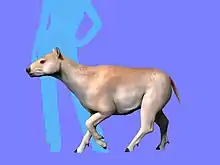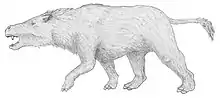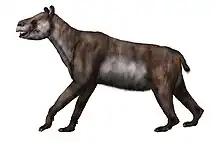Diplasiotherium
Diplasiotherium is an extinct genus of litoptern belonging to the family Proterotheriidae, that lived between the late Miocene and the early Pliocene (in the SALMAs Huayquerian and Montehermosan).[1] The fossils of this animal have been found in Argentina, in the Monte Hermoso Formation.[2][3]
| Diplasiotherium | |
|---|---|
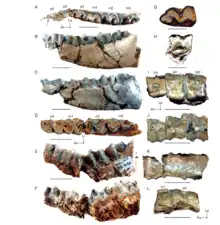 | |
| Fossils of Diplasiotherium pampa, from the Cerro Azul Formation | |
| Scientific classification | |
| Domain: | Eukaryota |
| Kingdom: | Animalia |
| Phylum: | Chordata |
| Class: | Mammalia |
| Order: | †Litopterna |
| Family: | †Proterotheriidae |
| Subfamily: | †Proterotheriinae |
| Genus: | †Diplasiotherium Rovereto, 1914 |
| Type species | |
| †Diplasiotherium robustum Rovereto 1914 | |
| Species | |
| |
Diplasiotherium is distinguished from other proterotheriids by the crown of its molars, which were higher than in other related genera (protohypsodont), and by its larger body size; the species D. robustum reached approximately 395 kilograms (871 lb) in weight, making it the largest known proterotheriid.[1][4]
References
- Villafañé et al., 2006, p.161
- Rovereto, Cayetano. 1914. Los estratos Araucanos y sus fósiles. Anales del Museo Nacional de Historia Natural de Buenos Aires 25: 1–247.
- Deschamps & Tomassini, 2016, p.224
- Villafañe, A. L. (2005). Paleoecología de los Proterotheriidae (Mammalia, Litopterna): Un estudio basado en los cambios en la masa corporal. Tesis de Licenciatura (inédita), Facultad de Ciencias Naturales (sede Trelew), Universidad de la Patagonia San Juan Bosco, 145 págs.
Bibliography
- Deschamps, Cecilia M., and Rodrigo L. Tomassini. 2016. Late Cenozoic vertebrates from the southern Pampean Region: systematic and bio-chronostratigraphic update in: M. Martínez y D.Olivera (Eds.), Palinología del Meso-Cenozoico de Argentina - Volumen en homenaje a Mirta Elena Quattrocchio. Publicación Electrónica de la Asociación Paleontológica Argentina 16. 202–225. Accessed 2019-04-08.
- Villafañe, A.L.; E. Ortiz Jaureguizar, and M. Bond. 2006. Cambios en la riqueza taxonómica y en las tasas de primera y última aparición de los Proterotheriidae (Mammalia, Litopterna) durante el Cenozoico. Estudios Geológicos 62. 155–166. Accessed 2019-04-08.
This article is issued from Wikipedia. The text is licensed under Creative Commons - Attribution - Sharealike. Additional terms may apply for the media files.

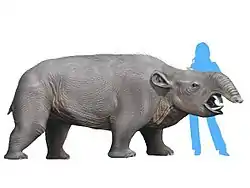
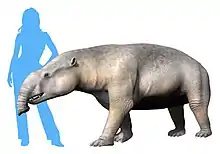
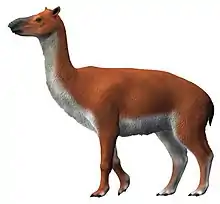
.jpg.webp)
